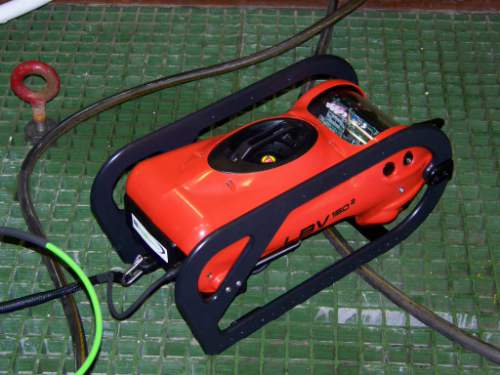Location: In the Drake Passage between the Antarctic Peninsula and South America.
Antarctic trivia (answer at end of this journal entry): Crabeater seals are the most numerous large mammals in the world, but they don’t eat crabs! What do they eat?
Disappointment turned to action today – we know that we may not get another chance to "do science” on the ice this cruise, so we took advantage of our transit time in the ice to collect some data.
Four people were sent in "the basket” over the side of the ship onto a small ice floe to collect ice cores for analysis.
 The ice party ascends in the basket over the side of the ship to the ice.
The ice party ascends in the basket over the side of the ship to the ice.
 Ice cores are taken for analysis on the ship.
Ice cores are taken for analysis on the ship.
The EMI (electro-magnetic induction) device housed in the kayak was calibrated and put into service today. The EMI induces an electric field in the ice below it and through a series of calculations ice thickness is determined.
 Mike and Blake adjust the cables that will suspend the kayak over the ice.
Mike and Blake adjust the cables that will suspend the kayak over the ice.
 The kayak is placed in position, then calibrated.
The kayak is placed in position, then calibrated.
The EMI worked well – ice thickness data from the EMI matched the data from the cores taken by the ice party on the floe. A remotely-operated vehicle (ROV for short) was deployed from the side of the ship and piloted under the ice. A camera on the ROV gave us a great view of what was underneath the ice.
 The ROV before deployment.
The ROV before deployment.
 Erik and Jeremy manage the ROV’s tether.
Erik and Jeremy manage the ROV’s tether.
 Watching a display from the ROV’s camera.
Watching a display from the ROV’s camera.
We also continued ice observations today as we left Palmer Station. We expected only a few hours of ice, but we were in bands of ice for the next 24 hours.
 Penny records ice observations while Steve and John watch the changing conditions.
Penny records ice observations while Steve and John watch the changing conditions.
Even though we’re headed back to port and face an uncertain future we made the best of the situation today by collecting as much data as possible.
For all my Greyhound friends back in Texas, here is the first installment of our own version of "Where’s Waldo.” Can you tell from the picture below where the greyhound is?
 Go Greyhounds!
Go Greyhounds!
Marine mammals and seabirds seen today by our mammal and bird exert, Brent: Cape petrel Snow petrel Antarctic petrel Giant petrel Blue petrel Slender billed prion Sooty shearwater White-chinned petrel Ross seal (a very rare sighting) Minke whale Antarctic fur seal Crabeater seal Southern elephant seal (another rare sighting)
Try this: Choose one of the animals in the list above and research the animal on the Internet or in your school library. Find out what makes your animal unique and how your animal is adapted to live in the harsh conditions found in Antarctica.
Answer to today’s Antarctic trivia question: Crabeater seals don’t eat crabs – they eat krill, which are small shrimp-like animals found under the ice. (Trivia question, part II – can you find out why they are called crabeater seals?)

